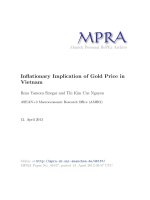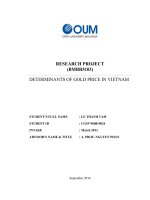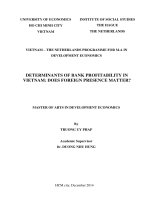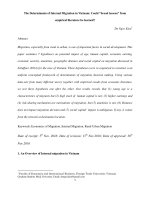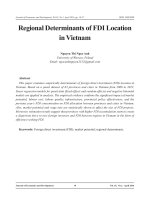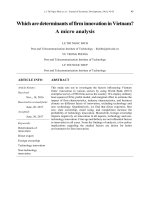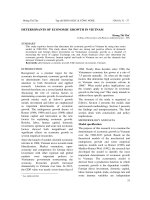Determinants of gold price in vietnam
Bạn đang xem bản rút gọn của tài liệu. Xem và tải ngay bản đầy đủ của tài liệu tại đây (1.74 MB, 72 trang )
RESEARCH PROJECT
(BMBR5103)
DETERMINANTS OF GOLD PRICE IN VIETNAM
STUDENT’S FULL NAME : LE THANH TAM
STUDENT ID : CGSVN00015024
INTAKE : March 2013
ADVISOR’S NAME & TITLE : A. PROF. NGUYEN PHAN
September 2014
1
Advisor’s assessment
Advisor’s signature
2
ACKNOWLEDGEMENT
Making a research is never easy. But what makes it fulfilling is the fact that
there are people around who, without thinking twice are willing to lend their hands.
To Dr. Nguyen Phan, our beloved adviser, for the unwavering support,
guidance, and patience he has shown.
To our families for their love, provisions, support, and understanding before,
during, and after the research process.
And to my classmates for providing the researches with amazing grace and
wisdom that only they can give.
With the abovementioned names, I would like to extend the utmost gratitude
with all my hearts.
3
TABLE OF CONTENTS
LIST OF TABLES 5
LIST OF FIGURES 6
ABSTRACT 7
CHAPTER 1: INTRODUCTION 8
1.1. Problem statement 8
1.2. Research Objective 10
1.3. Research Questions 10
1.4. Research scope 11
1.5. Research methodology 11
1.6. Data collection 12
1.7. Research structure 12
CHAPTER 2: LITERATURE REVIEW 13
2.1. Impacts of inflation 13
2.2 Impacts of exchange rate 18
2.3. Impacts of demand and supply factors 21
2.3.1. International market 21
2.3.2. Vietnam market 26
2.4. Gaps in literature 29
CHAPTER 3: RESEARCH METHODOLOGY 30
3.1. Data sources 30
3.2. Variables 30
3.2.1. Dependent variable 30
3.2.2. Independent variables 30
3.3. Modeling specification 31
3.4. Methods of estimation 32
3.4.1. Test for the statistical significance 34
3.4.2. Test for heteroscedasticity 35
3.4.3. Test for multicollinearity 35
3.4.4. Test for the assumption of normality 36
4
3.4.5. Test for autocorrelation 37
3.5. Hypotheses 38
3.5.1. Hypothesis 1 – CPI 38
3.5.2. Hypothesis 2 – Interest rate 38
3.5.3. Hypothesis 3 – USD/VND Exchange rate 39
3.5.4. Hypothesis 4 – VN-Index 39
3.6. Limitation 39
CHAPTER 4: EMPIRICAL RESULTS AND DISCUSSION 41
4.1. Test for the statistical significance 42
4.1.1 Individual significant test: 42
4.1.2. Joint significance test 46
4.2. Test for heteroscedasticity 48
4.3. Test for multicollinearity 49
4.4. Test the assumption of normality 49
4.5. Test for autocorrelation 51
4.6. Interpretation of regression results 52
CHAPTER FIVE: CONCLUSIONS 58
5.1. Limitation 58
5.2. Suggestion 58
5.3. Recommendation 59
5.4. Conclusion 60
REFERENCES 62
APENDIX 1: Data of variables from January 2009 to June 2014 66
APENDIX 2: Global and Domestic Gold Price in Vietnam 70
APENDIX 3: Recent Gold Price Developments: May 2012 – March 2013 71
5
LIST OF TABLES
Table 1: Gold Companies in the Forbes Global Top 2000 21
Table 2: Gold production countries from mining in 2013 22
Table 3: Global mine production of gold from 2005 to 2013 (in metric tons) 23
Table 4: Consumer demand Viet Nam four quarter totals (tons) in 2008-2013 27
Table 5: The result of individual significant test on CPI 42
Table 6: The result of individual significant test on VN-Index 43
Table 7: The result of individual significant test on Exchange rate 44
Table 8: The result of individual significant test on Interest rate 45
Table 9: The result of joint significant test 46
Table 10: The result of Test for heteroscedasticity 48
Table 11: The result of Test for multicollinearity 49
Table 12: The result of Test the assumption of normality 50
Table 13: The result of Test for autocorrelation 51
6
LIST OF FIGURES
Figure 1: Movements of Vietnamese gold price and nominal interest rate from
01/2009 to 06/2014 52
Figure 2: Movements of Vietnamese gold price and USD/VND rate from 01/2009
to 06/2014 53
Figure 3: Movements of Vietnamese gold price and Vietnamese Consumer price
index (CPI) from 01/2009 to 06/2014 54
Figure 4: The movements of Vietnamese gold price and VN-Index from 01/2009 to
06/2014 55
7
ABSTRACT
With the investment demand for gold being on the rise, and a complex set of
factors influencing the investment demand for gold, forecasting the price of gold is
seen essential but difficult. In addition, although Vietnam gold prices have a huge
influence from world prices but still have negatively correlated in some periods.
The paper makes an attempt to identify the factors influencing the price of gold by
using the monthly prices of gold for the period from 2009 to 2014. The paper then
tries to identify the factors influencing the price of gold using the multiple
regression analysis.
The researcher used four independent variables that affect the prices of gold
in Vietnam which are Vietnamese consumer price index, exchange rate, interest
rate, and VN-Index. The empirical results have found there is negatively significant
relationship between VN-Index on gold prices, while CPI, exchange rate and
interest rate are positively significant. The results of the study are valuable for both
academic and investor.
Keywords: determinant, gold price, CPI, exchange rate, interest rate, VN-
Index
8
CHAPTER 1: INTRODUCTION
1.1. Problem statement
Gold, one of the most precious metals mined has been widely used as a
currency in the past. Today though its role for monetary purpose is limited, it is
highly valued as a commodity for some industrial purposes and is widely bought as
jewelry and seen as an asset for investment. Globally, the gold that is produced is
consumed 50 percent as jewelry, 40 percent in the form of investments and 10
percent by industry (Robert, 2006).
Gold has played an important role in the history throughout the world. The
reason is because gold is scarce; therefore gold manages to retain its value. Due to
this, gold has been commonly used as a safety in the case other form of money is
constantly devaluing. Investing in gold is usually associated with the fears of high
inflation period and political risk. Gold is in fact one of the most liquid asset during
political risk, such as war, and etc.
Gold is a natural resource that has a notable value for investments. Investors
invest in gold for various reasons, which vary from hedging purposes to speculative
investment.
There is risk in every investment, considering gold price fluctuates
constantly in the short run and considerably stable in the long run (Levin and
Wright, 2006). As the price of gold fluctuates less in the long run, gold can be used
as hedge instrument against inflation in the long run. Levin and Wright (2006)
found that the price of gold in the long run follows the general price lever
proportionately, that one percent increase in the US general price level leads to one
percent increase in the price of gold. Gold is a long run hedge against inflation is
also backed up by the findings by Gosh et al. (2004), which found that the price
elasticity of gold, compared to US CPI is 1.1. Another studies proposed that gold is
9
not an effective hedging tool against inflation in the short run, as the price of gold
fluctuates too much.
Gold return is independent of any other asset, because gold is believed to
have negative beta (Levin and Wright, 2006). It means that the return of gold goes
in the opposite direction with the market return. Therefore, gold is a good portfolio
diversifier. Jaffe (1998) found out that adding 5-10% of gold investments to a
portfolio provides a better return compared to portfolio without gold at all.
As gold is an important form of investment nowadays, it is important to
know the factors that determine the price of gold. There are three gold pricing
models available conducted in the research: Macroeconomic approach,
Speculations/Rationality of gold price movements approach, and Inflation Hedge
approach. Macroeconomics approach explains that the movements in the price of
gold are caused by macroeconomics variables. Speculation or rationality of gold
price movements approach analyses whether any speculation or rationality assumed
has an effect in the gold price movements. The inflation hedge approach
concentrates on the movement of price of gold based on the inflation rate. This
thesis will provide past empirical research regarding these three methods. The
inflation hedge approach will be used in conducting this research. Vietnam is the
world’s 47
th
largest gold producer (British Geological Survey, 2010), and the
demand for gold in Vietnam keeps on increasing. With Vietnamese economy,
which is affected by the appreciation and depreciation of other currency, the price
of gold in Vietnam is very vulnerable. Therefore, in this research, the author would
like to test the factors that determines the price of gold in general, affects the long
run and short run price of gold in Vietnam.
Therefore, in accordance with the outline above, this research is titled as:
“Determinants of Gold Price in Vietnam”
10
1.2. Research Objective
The aim of this research is to study the determinants of the price of gold in
Vietnam. The research is conducted using some macroeconomic variables, which
are believed to affect the price of gold in the long run. The results of this research
will then be evaluated with the previous study in the same field.
To achieve this overall goal requires meeting the following specific
objectives:
(1) The first objective is to study and quantify the impact of variables on
gold price. We will identify and examine the main factors affecting gold price in
Vietnamese market. Some studies on other markets in the past defined various
determinants and movements of gold price. In this research, we want to give a clear
view on the most important divers having effect on Vietnamese gold price from
January, 2009 to June, 2014.
(2) Based on the thorough understandings about the determinants of gold
price in Vietnam, the second objective is to suggest appropriate solutions to help
investors reduce the risk and gain return when investing in Vietnamese gold market
and help the government manage better the price of gold.
1.3. Research Questions
This research is aimed at trying out and testing the impact of determinants
affecting gold price in Vietnamese market. The study attempts to answer the
research questions as follows:
- Question 1: What are the determinants of gold price and to what extend do
they affect gold price in Vietnamese market in period of time from January, 2009 to
June, 2014
11
- Question 2: What are the solutions for investors to reduce the risk and gain
return when investing in Vietnamese gold market and for the government to manage
the gold price more effectively?
1.4. Research scope
This research aims to analyze the determinants of the price of gold in
Vietnam, which is based on the data of price of gold from the period 2009 to 2014.
Besides that, the author is focusing on the factor that determines the price of gold
for investments and hedging purposes.
1.5. Research methodology
In an academic research, there are two main method choices: qualitative or
quantitative (Saunders et al., 2009).Quantitative research assumes that facts have an
objective reality, variables can be identified, and their relationships measured. A
quite understandable point as quantitative data is all about numbers. The purpose
with this approach is to generalize facts and understandings, and not to think too
much about the individual case, but instead what it means for the science in general,
(Glesne and Peshkin, 1992). Quantitative data can be described as research in which
the focus lies on numbers, statistics and facts. They can be obtained from surveys or
data already collected and presented by others (referred to as secondary data). As
the name refers to, the quantity or mass of data handled should be substantial and
essential. In general, quantitative data gives a broad, general answer to the problem,
while qualitative data lets readers get deep into the question and understand why
and how things are as they are (Jacobsen, 2002).
According to Creswell (2008), quantitative researches relies on empirical
data, objectivism and in general tries to verify theories and use standards of validity
and reliability. The quantitative method is therefore more appropriate for this
research’s purpose because this study bases on objective historical data. Surveys or
questionnaires are conducted; instead this study used secondary data to reach to
12
empirical findings. Because this study is looking for a general answer to its
problem, this method was chosen as the most suitable.
1.6. Data collection
After specifying all the dimensions above, the next step is to select a type of
data and its sources. There are three categories of literature sources available:
primary, secondary and tertiary (Saunders et al., 2009, p. 69). The current research
requires utilizing of secondary data, such as books, journals, newspapers and
databases. The data used in the modeling are monthly observations from the last day
of the month covering the period from January 2009 to June 2014. Monthly samples
are chosen because many studies did the same with the short period of time, for
example, studies of Pindyck (1993), Gosh et al. (2002), Kolluri (1981), etc. In
addition, the data related to interest rate, consumer price index, exchange rate are
not observed daily or weekly.
1.7. Research structure
The thesis is organized in five chapters, including this introduction. Chapter
1 gives an overall picture of the subject related topic background, topic relevance,
relevance of research question, overview of dissertation structure. Chapter 2
reviews theories of gold price’s determinant. Chapter 3 describes data collection
and methodology in which the model for estimation and method of estimation are
outlined. Chapter 4 presents the results from analyzing data and discussion. Chapter
5 briefly draws the conclusion, recommendations and limitations of the thesis.
13
CHAPTER 2: LITERATURE REVIEW
In this chapter, an overview of international and Vietnamese gold markets in
history will be discussed, as well as the review on previous related literature and
developed hypotheses. We are going to look into the researches done on
determinants of gold price, which are CPI, exchange rate, interest rate, and VN-
Index. In these fields, there have been a number of researches done based on
different purposes, such as the influence of inflation rate on GDP, impacts of
exchange rate on international trade, influences of demand & supply factors on gold
price, and so forth. Thus, we are going to investigate how these factors are
influencing gold as a medium to reduce investment risks.
2.1. Impacts of inflation
Dipak et al. (2002) published a paper in researching gold as an inflation
hedge. He has explained that inflation hedge price is the dollar price that gold
would have to be in order to maintain its purchasing power. In his findings, the
nominal price of gold was $384 per ounce in January 1982 and $283 in December
1999. He concluded that gold was not a short-run inflation hedge between these
years. He had suggested, from his theoretical model, that sizeable short-run
movements in the price of gold are consistent with the gold price rising over the
time with the general rate of inflation. In addition, from the monthly gold price
analysis data (1976-1999) and co-integration regression techniques provided by
Dipak et al. (2002) have confirmed that gold can be regarded as a long-run inflation
hedge and the movements in the nominal price of gold are dominated by short-run
influences.
Later on, Worthington& Pahlavani (2006) also conducted a study on gold
investment and inflation hedge, and they published it with the title “Gold
Investment as an inflationary hedge: Co-integration evidence with allowance for
endogenous structural breaks”. They used the monthly price of gold and inflation in
the United States from 1945 to 2006 and from 1973 to 2006, which was newer than
14
the data presented by Dijak et al. (2002). Furthermore, they were stressed that their
analysis in using monthly gold price data (1976-1999) and co-integration regression
techniques provides empirical confirmation that gold can be regarded as a long-run
inflation hedge. They were concluded that inflation hedging quality of gold depends
on the presence of a stable long-term relationship between the price of gold and the
rate of inflation.
Eric J Levin and Robert E Wright (2006) studied about the determinants of
the price of gold in short-run and long-run. According to Eric and Robert (2006),
they developed a theoretical framework based on the simple economics of “supply
and demand” that is consistent with the view that gold is an inflation hedge in the
long-run and it also allows the price of gold to fluctuate considerably in the short
run. They stated three findings in their papers. The first finding is that there is a
long-term relationship between the price of gold and the US price level, followed by
second finding, which is the US price level and the price of gold moved together in
a statistically significant long-run relationship supporting the view of that one
percent increase in the general US price level leads to a one percent increase in the
price of gold. Thirdly, they were stated that, in the wake of a shock that causes a
deviation from this long-term relationship, there is a slow reversion back towards it.
In this paper, they were concluded that there is a long term one-for-one relationship
between the price of gold and general price level in the USA. In other words, one
percent rise in US inflation raises the long-term price of gold by an estimated one
percent. Despite of this, there are short-run deviations from the long-run
relationship between the price of gold caused by short-run changes in the US
inflationary rate, inflation volatility, credit risk, the US dollar trade-weighted
exchange rate and the gold lease rate. In addition, third finding has been proven as
there is a slow reversion towards the long-term relationship following a shock that
cause a deviation from this long-term relationship.
15
In fact, all of the above empirical studies focused on the direct relationship
between inflation and the price of gold. The empirical studies below focused on the
indirect relationship between inflation and the price of gold, such as inflation and
investments, inflation and performance of stock markets, and so forth.
John H. Boyd, Ross Levine, and Bruce D. Smith (2000) studied about the
impact of inflation on financial sector performance. In this paper, they empirically
assessed the predictions of the rate of inflation interfere with the ability of the
financial sector to allocate resources effectively. They had quoted from Huybens
(1998) and Smith (1999); recent theories emphasize the importance of informational
asymmetries in credit market and demonstrate how increases in the rate of inflation
adversely affect credit market frictions with negative repercussions for finance
sectors performance and therefore long-run real activity. Furthermore, they quoted
from Boyd and Smith (1998); Huybens and Smith (1998, 1999) that the related
models suggest the existence of a third inflation threshold. According to this
threshold, in some cases, once the rate of inflation exceeds the critical level, perfect
foreign dynamics do not allow an economy to converge to a steady state displaying
either an active financial system or a high level of real activity. In other words,
further increase in inflation after exceeding the critical level will have no additional
consequences for financial sector performance or economic growth. Throughout
this paper, they had shown the evidence that indicates that there is a significant and
economically important, negative relationship between inflation and financial
development. Furthermore, they also found that the empirical relationship between
inflation and financial sector activity is highly non-linear. One of the examples
provided by John et al (2000) is that in low-inflation countries, the data indicates
that more inflation is not matched by greater nominal equity returns. John et al
(2000) stress that this finding is consistent with the theories outlined in the
Introduction of his paper.
16
Mohammed Omran and John Pointon (2001) conducted a research in
determining whether inflation rate affect the performance of the stock markets. In
this paper, they were examining the impact of inflation rate based on the
performance of Egyptian stock market. They also paid attention to the effects of the
rate of inflation on various stock market performance variables in terms of market
activity and market liquidity. According to Mohammed and John (2001), the results
revealed an expected behavior for the stock market response to the decrease in the
inflation rate, and the results regarding overall performance seem consistent as there
is an inverse relationship between the inflation rate and both stock returns and
prices.
Patrick Honohan and Philip R. Lane (2004) of The World Bank and
Economic Department discussed about the exchange rate and inflation under
Economic and Monetary Unition, EMU. The purpose of this paper is to provide
updated information from their previous work, which was about the exchange rate
and inflation under EMU. In this paper, they updated and extended the exchange
rates matter for EMU inflation rates during periods of euro appreciation (2002-
2003) as well as periods of euro depreciation (1991-2001). Next, they were also
provided an analysis of quarterly data over 1999.1-2004.1. They confirmed the
connection between exchange rates and inflation. When the exchange rate is
excessively weak, inflation rises in order to correct under-valuation, or vice versa.
M. Kannadhasan (2006) is concerned about the effects of inflation on capital
budgeting decisions. In his research paper, ‘Effects of Inflation On Capital
Budgeting Decisions—An Analytical Study’, he stated that in practice, managers do
recognize that inflation exists but rarely incorporate inflation in the analysis of
capital budgeting because they were assuming that with inflation, both net revenues
and the project cost will rise proportionately. However, it was incorrect. In the
purpose of presenting the correct path, he had divided his research paper into two
parts: discussion about inflation, how to measure inflation and the effects of
17
inflation on GDP, and the second part, effects on inflation on capital budgeting
decisions, concerning about how to deal with expected and unexpected inflation
while forecasting cash flows and determining the discount rate in particular.
According to M. Kannadhasan (2006), inflation is measured by observing the
change in the price of a large number of goods and services in an economy, and it is
usually based on data collected by government agencies. As similar to other
explanation, he had explained that inflation rate is the rate of increasing in the price
index. He had described price level as measuring the size of the balloon, while
inflation refers to the increase in its size. In his findings, he had concluded that
effects of inflation are significantly influenced on capital budgeting decision
making process. He was also recommended that finance manager should take into
organize the effects of inflation.
Dorel Bercanu and Anca Bandoi (2009) have done their research in
investigating how inflation influences about investment decision. They had stated
that the activity of investment in a company is based on strategy of economic
development set at the level it held and also based on the investment programs or
projects. Meanwhile they defined the meaning of project investment as a complete
and autonomous action involving the achievement of its investments and
exploitation of its long life. They have stated that inflation represents the
accelerated growth and the general level of prices, matched by increased money,
low purchasing power of money and depreciation under the influence of economic,
monetary, social, domestic and foreign policy. As discussed in Chapter One, we
knew that international monetary system started with the backup of gold standard,
and thus, the increasing of inflation rate can positively or negatively influence the
price of gold. Dorel and Anca (2009), used simple criteria or criteria based on
discounting the present value criteria (NPV). Through data analysis, they concluded
that in taking decisions in investments, investors should take the influence of
inflation into account and thus, right decision could be made.
18
2.2 Impacts of exchange rate
According to Mika& Eero (2007), evidence indicated that the US Inflation,
world inflation volatility, US-world exchange rate index, beta of gold and credit risk
default premium were all statistically significant variables. In their research paper,
they quoted Capie, F., Mills, T.C. and Wood, G (2004), had examined one aspect of
the second role of gold, which is gold as hedge against US dollar. Capie et al (2004)
was using data from 1971 to 2002, and then applied a variety of statistical
techniques to explore the relationships between gold and the exchange rates of
various currencies against the US dollar, with particular attention paid to the
hedging properties of gold in episodes of economic or political turmoil. As a result,
they were found that US dollar gold price move in opposition to US dollar and the
movement was essentially contemporaneous.
Kuan-Min& Yuan-Min (2010) published their research “Could Gold Serve
as an Exchange Rate Hedge in Japan?” In this paper, they attempted to examine
whether gold could be an exchange rate hedge in Japan using data from 1986 to
2007. According to Kuan-Min& Yuan-Min (2010), most researches have focused
on a linear relationship between returns on gold and the exchange rate, but they
were using the depreciation rate of the yen as a threshold variable to distinguish
between a high depreciation regime and a low depreciation regime. As a result, they
were found that when the yen depreciation rate is greater than 2.6%, investing in
gold could avoid the depreciation loss.
Bedjo Santoso (2010) studied about the effects of G-8’s GDP, US dollar
exchange rate and gold exchange rate to the Indonesian export. G-8 is the largest
importer for Indonesian products. G-8 countries are USA, Germany, French, Italy,
UK, Italy, Russia, Canada and Japan. In this paper, he examined the implication of
G8’s GDP, US dollar exchange rate change, and exchange price of Gold on the
demand export of Indonesia. Throughout this study, it is clearly shows that US
dollar exchange rate variable has a negatively relationship in the long term with
19
Indonesian export, and it also effects the export volume decrease in the short-run.
Despite from it, gold exchange rate and G-8’s GDP have positively and
significantly impacts in the long run. Meanwhile, the changing of the variables was
adjusted around 6% by export variable in the short run. Furthermore, a positively
relationship is found between the volume of exports with gold exchange rates, and it
is significant in the short term. According to Bedjo (2010) there is an opportunity
for using gold base currency as a better alternative.
All of the empirical studies above had direct relationship between exchange
rate and the price of gold. Inversely, the empirical studies below were having
indirect relationship between exchange rate and the price of gold. For example,
exchange rate strategies on trade and foreign direct investment.
A. Lahrèche-Révil and A. Bénassy-Quéré (2001) conducted a study
regarding of the impact of exchange rate strategies on trade and foreign direct
investment in China. According to Lahrèche and Bénassy (2001), the research
examined the impact of potential changes in the exchange-rate strategy of China on
the amount and distribution trade and foreign direct investment in China. They also
stated that exchange-rate regimes are defined through the joint behavior of the real
exchange rate level and the nominal exchange rate volatility. In this paper, they
managed to draw several conclusions. Firstly, they concluded that real exchange
rate is likely to be increasing concern for both trade and foreign direct investment in
China. Next, exchange-rate regimes play a role for attracting FDI in China although
they were unable to successfully demonstrate an influence of exchange-rate
uncertainty on trade.
Christian Broda and John Romalis (2003) conducted a study for identifying
the relationship between trade and exchange rate volatility. According to Christian
and John (2003), a model of international trade in which international trade
depresses real exchange rate volatility and exchange rate volatility impacts trade in
products differently according to their degree of differentiation. In this study, they
20
were using disaggregate trade data for a large number of countries for the period
1970-1997. Strong results were found in supporting the prediction that trade
dampens exchange rate volatility. Christian and John (2003) stressed that their
empirical model attributes most to the correlation between trade and volatility to the
effect that trade has in depressing volatility. Some evidences about the real
exchange rate volatility depress trade in differentiated goods are found in this paper.
Thus, we know that real exchange rate have direct relationship in international
trade.
Michael W. Klein and Jay C. Shambaugh (2005) conducted a similar study
which emphasized in observing fixed exchange rates and trade. In this paper, they
used a new data-based classification of fixed exchange rate regimes. As result, it
shows a large and significant effect of a fixed exchange rate on bilateral trade
between a base country and a country that pegs to it. Furthermore, according to
Michael and Jay (2005), these results have suggested an economically relevant role
for exchange rate regimes in trade determination since a significant amount of
world trade is conducted between countries with fixed exchange rates. In this paper,
they were found that with few controls pegging appears to have increase trade by
approximately 80%. Thus, we believe that fixed exchange rate does encourage
trading as well as gold trading.
21
2.3. Impacts of demand and supply factors
According to Dijak et al. (2002), theoretically models verify whether gold
can serves as an inflation hedge. Both of the theoretically models were focused in
one of the determinants of gold price, which is demand and the supply of gold. The
first model was focused in determining the effects of demand and supply of gold in
short-run, while second model was focused in determining the effects of demand
and supply of gold in long-run. As a result, they determined that in the short-run,
demand and supply of gold did not have statistically significant relationship to the
price of gold, meanwhile, in the long-run, demand and supply of the gold did have
statistically significant relationship to the price of gold.
Furthermore, with the statistic published by WGC (2011) in “Gold Demand
Trends” analyzed on the demand of the gold in terms of jewelry, investment,
technology, and supply of the gold in terms of mine production, recycled gold,
central banks, and gold production.
2.3.1. International market
- Supply:
Gold is a rare metal. The major gold entering the market comes from three
sources: mining, recycling and official sector sales. In term of mining source, The
Forbes Global Top 2000 (2011) includes 12 gold companies. The biggest is the US
Newmont Mining; six are from Canada, two from South Africa, and one from
Australia, Peru and Russia.
22
Table 1: Gold Companies in the Forbes Global Top 2000
Source: Forbes Magazine, 2011
The increase in gold coming from mines only started from 2008, which is
two to three years after the start of the boom in the gold price. The reason for this
slow reaction is the required time to open a new mine for gold digging. Since the
financial crisis, governments and central banks (official sector) stopped liquidating
their gold reserves and even started to increase their gold reserves. Central banks try
to diversify their assets as much as possible and try to reduce their assets in Euros or
Dollars, because they fear a fierce depreciation in the future.
23
Table 2: Gold production countries from mining in 2013
Source: United States Geological Survey, 2013
24
Table 3: Global mine production of gold from 2005 to 2013 (in metric
tons)
Source: United States Geological Survey, 2013
- Demand:
+ Reserve demand for gold of Central Bank:
Central banks, international entities (e.g. International Monetary Fund) and
governments are the single largest holder of gold in the world. These institutions
controlled end of 2009 16.2 per cent (26,780 tons) of the worldwide available gold
(World Gold Council).This corresponds to a market value of 7,950 billion US
dollar, based on a gold value of 1427 dollar per ounce. According to World Gold
Council (2009), in the last years, several central banks, notably from Russia, India
and China, have announced plans to increase their gold reserves. As a consequence,
in 2009 central banks have become for the first time in 20 years net buyers of gold.
